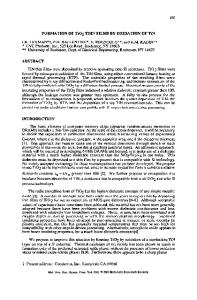Enhanced Oxidation of TiSi 2 Films by As + Implantation
- PDF / 936,226 Bytes
- 6 Pages / 420.48 x 639 pts Page_size
- 27 Downloads / 374 Views
ENHANCED OXIDATION OF TiSi 2 FILMS BY As+ IMPLANTATION* O.W. HOLLAND AND D. FATHY Solid State Division, Oak Ridge National Laboratory, Oak Ridge, TN 37831 ABSTRACT The influence of As+-ion implantation on the oxidation of TiSi 2 films is investigated. It will be shown that implantation leads to a greatly increased rate of oxidation in a dry 02 ambient. Low-temperature oxidation of the implanted films not only results in substantial oxidation of the films, but completely alters the films' morphology. Different implantation techniques were used to isolate the effects of ion-induced damage from chemical effects, so that each could be separately studied. It will be shown that neither chemical nor damage effects are able, by themselves, to account for the enhanced oxidation. Rather, a model is proposed to explain the role of implantation in the oxidation process which depends on a synergistic relation between these two effects. INTRODUCTION The use of refractory metals and their silicides for electrodes, interconnects, and contacts in Si integrated circuits is increasing because of their low resistivity and thermal stability. Novel processing schemes have been proposed which utilize implantation of the silicides. Silicidation of source/drain and gate regions in metal-oxide-semiconductor (MOS) transitor circuits has been used to reduce the sheet resistance of these regions and thereby increase circuit performance [1]. This is normally accomplished by thermally reacting a deposited refractory film with the Si substrate. There are advantages in forming the junctions after silicidation by implanting through the metal film [2]. One obvious advantage of this technique is that ion-channeling of the implanted dopant is reduced resulting in better control of junction depths. Also, the silicide reaction tends to be nonuniform [3]. This causes thickness variations across the film which can lead to leaky or shorted junctions. Implantation through the silicide solves this problem by aligning the junction with the silicide edge. The formation of junctions by ion implantation superseded the use of diffusion furnaces because it offered better control of doping levels and junction depths. However, junction depths are becoming so shallow in ultra-large scale integrated circuits that problems with implantation, such as channeling, shadowing by topography [4], and ion-induced damage removal, begin to limit its use. To circumvent these problems and still enjoy the advantages of implantation, the industry is beginning to use a hybrid technique whereby dopant is implanted into an overlying film (usually silicide) and then diffused into the Si substrate to form the junction. Therefore, a knowledge of the effects of implantation on the silicide's properties and its behavior during subsequent processing steps is required. In this paper, the effect of implantation on the thermal stability of thin, titanium disilicide films in an oxidizing ambient will be discussed. Both the morphology of the films, and the dopant behavior were determined. It will
Data Loading...











